Excerpt from the Frederick News-Post:
Roughly two dozen members of the Frederick County Agricultural Society filled Frederick City Hall on Thursday during the city’s Historic Preservation Commission meeting.
They waited patiently through the first two and a half hours of discussion and decisions before time came for the last item on the meeting agenda. Then, fireworks erupted.
At issue was a recommendation to place a historic preservation overlay on part of the Frederick Fairgrounds property at 797 E. Patrick St.
An overlay is an extra layer of regulations on top of zoning requirements already in place. If approved, the designation would give the Historic Preservation Commission authority to review and approve major exterior changes to the properties.
Although the designation is intended to protect the city’s historic buildings and sites, Anne Rollins, an attorney with Miles & Stockbridge, the firm representing the agricultural society, which owns the fairgrounds, framed the application a bit differently.
The designation would have a “serious and negative impact” on the use and function of the fairgrounds, she said in the Thursday hearing. She added that the application, submitted not by the property owner but by the historic preservation commission itself, was “tantamount to the unconstitutional taking of our property without just compensation.”
Rollins also contested the historic value of the sites and structures proposed for the overlay.
The 135-year-old site provides information and context for the agricultural industry in Frederick, and the region as a whole, according to the commission staff report submitted by Lisa Mroszczyk Murphy. The proposed overlay boundary includes 21 buildings and structures, including the racetrack and tunnel beneath it, the grandstand, the show ring and the farmers market building.
But Rollins said all of those buildings have been renovated, and are no longer in their original condition. The grandstand underwent renovations in the 1960s, 1980s and again recently to comply with Americans with Disabilities Act requirements. The racetrack gets resurfaced at least twice per year, and the farmers market has undergone modifications as well.
Many of the structures also use vinyl, which, as Rollins noted, is not allowed under the guidelines for the Frederick Town Historic District.
Despite her comments, the commission voted 5-2 to recommend the overlay. The approval was not without heated debate among commission members, though.
Dan Lawton, who voted against the overlay, said he found the property owner’s arguments compelling.
“I wish this property owner wanted that extra layer of protection, but that’s just a wish, and that’s not reality,” he said. “The reality is, if [the fairgrounds] economically fail, if this group of people doesn’t keep it as a fairground, who’s going to make it a fairground?” he asked.
Stephen Parnes, who also opposed the overlay, pointed to the larger problems with the process of picking properties to designate.
Unlike downtown property owners, who realize the impact the Frederick Town Historic District will have when they buy real estate, these property owners had no forewarning, Parnes said.
“I knew what I was buying into when I moved downtown,” he said. “I don’t think Frederick Fairgrounds and its board bought into what we’re trying to recommend.”
But Scott Winnette, commission chairman, questioned by Parnes was objecting to the process now. The commission previously recommended five other sites for designation, some of which were met with protest from the owners of those properties.
For Winnette, it was a question of integrity, and of historic preservation. And those won out over property owners’ concerns.
The commission also voted on Thursday to recommend an overlay at Schifferstadt Architectural Museum at 1110 Rosemont Ave. and the Monocacy Brewing Co. property — locally known as the Ebert’s Dairy building — at 1781 N. Market St.
All three recommendations will be reviewed by the Planning Commission before going to the mayor and Board of Aldermen. The aldermen have final authority to approve or deny the designations, regardless of what the commissions recommend.
Roughly two dozen sites were identified in the city’s 2010 Comprehensive Plan as potentially eligible for similar designations. A designation committee will continue to make recommendations for or against historic designations on the remaining properties.



